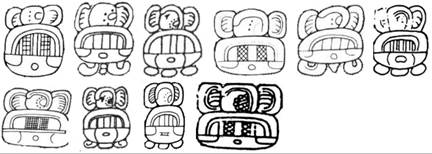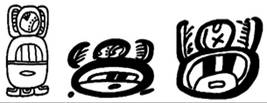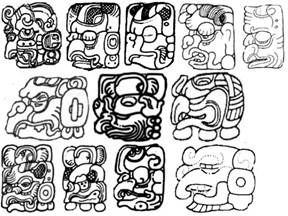![]()
![]()

K&H.p55.#2.2 TOK.p34.r3.c2 = BMM9.p21.r5.c4 25EMC.pdfp51.#2.1&2
WINIKHAAB? WINIKHAAB WINIKHAB WINIKHAB / WINAKHAB


K&L.p62.#3 IC.p16.pdfp20.#4.1&2
WINIKHAAB K’ALTUUN


![]()
MHD.ZH1.1&2&3 0028ta 0028tv 0028tt 0028dt
WINIKHA’B WINIKHAAB WINIKHAAB


Montgomery = Coll-1
YAX HS2 Step 7 N1
15.WINIKHAAB
![]()
![]()
![]()
![]()

K&H.p55.#2.1 TOK.p27.r1.c4 BMM9.p19.r6.c1 25EMC.pdfp51.#2.3&4&5 IC.p16.pdfp20.#4.3&4
WINIKHAAB? WINIKHAAB WINIKHAB WINIKHAB / WINAKHAB K’ALTUUN




K&L.p62.#4.1-12 MHD.SB2 MHD.SB4.1&2&3 MHD.SB6
WINIKHAAB WINIKHAAB? WINIKHAAB? WINIKHAAB?
![]()
0028hs
WINIKHAAB
![]()
![]()
K&L.p62.#4.13 = IC.p16.pdfp20.#4.6 IC.p16.pdfp20.#4.5
YAX Lintel 48 B5-B6 PAL PT B5-B6
WINIKHAAB K’ALTUUN
· Variants (4):
o A. Abstract:
§ <ka.TUUN.ka>:HAAB.
§ (Optionally) three touching or non-touching dots at the bottom.
· This is often indicated in CMGG transliterations with a “blue dot” (“●”) – an element which sometimes occurs at the bottom of the HAAB, but which otherwise is not a reflection of anything in the pronunciation.
· Are there some epigraphers who consider this element to be a variant of ba, making it perhaps an end phonetic complement for (WINIK)HAAB?
§ Bonn gives a sub-variant of the ka-comb variant – a reduced form consisting basically of the top of the abstract form of HAAB.
· <ka.TUUN.ka>: 0028tt.
· <ka.TUUN>: 0028dt.
· Surprisingly, there isn’t a sub-variant <TUUN.ka>.
Bonn’s 0028tt/0028dt are the only examples I know of – the printed pedagogical sources do not give this variant.
o B. Bird-head:
§ AT-E1168-lecture6.t0:34:55-36:55 discusses the head variants of PIK, WINIKHAAB, and HAAB. For WINIKHAAB, Tokovinine explains:
· It’s an eagle-like bird.
· The eye has a HIX infixed. This is either a “full” HIX [Sim: or just three non-touching dots in a triangular formation, triangle pointing downwards].
· It’s very similar to (one of the variants of) the logogram for CHAN = “sky”. (Sim: see some of the variants of K’ahk’ Hoplaj Chan K’awiil and K’ahk’ Yipyaj Chan K’awiil.)
· Bonn doesn’t seem to have a bird-head variant for WINIKHAAB (2024-10-01).
§ Summary of distinguishing characteristics: a bird-head (usually with two syllabogram o feathers, one on each side of the head) with neither a hand-jaw nor a bone-jaw, just a downturned beak. [Note that K&L.p62.#4.9&10 have the top of the abstract form of WINIKHAAB – i.e. the TUUN/ku between two syllabogram ka combs – on top of the bird head itself.]
§ It’s well estabilshed that PIK, WINIKHAAB, HAAB each have a bird-head variant. The bird-head has:
· In PIK: A hand-jaw.
· In WINIKHAAB: Neither a hand-jaw nor a bone-jaw.
· In HAAB: A bone-jaw.
It’s interesting to note that:
· MHD has a variant of WINIKHAAB with a hand-jaw (MHD.SB2), normally associated with PIK.
· MHD has a variant of WINIKHAAB with what might be a bone-jaw (MHD.SB6), normally associated with HAAB.
This is probably due to the fact that these glyphs exist on monuments with precisely these characteristics and the context in which they occur compel their reading as WINIKHAAB (instead of as PIK or HAAB respectively, despite their uncharacteristic features).
o C. Head:
§ This is simply the animated form of the abstract variant – it has the abstract variant infixed in a (somewhat) generic head – perhaps that of an old man.
§ Bonn’s 0028hs is the only example I know of – the printed pedagogical sources do not give this variant.
o D. Full figure:
§ So far, I’ve only seen them in PAL PT and YAX Lintel 48.
· MHD statistics (2024-10-02). These statistics are available only for the abstract and bird-head variants. This is because I’m not aware of MHD codes for the other two variants – if they even exist. And even if they did and I knew them, the number of hits for these two obscure variants would probably be extremely low anyway. Also, the three bird-head variants are rolled into one group for convenience). The MHD search was “blcodes contains <3-character-MHD-code>”):
o Abstract/MHD.ZH1: 1,123 hits.
o Bird-head/MHD.(SB2+SB4+SB6): 324 hits (= 13+248+63 hits).
This shows that the abstract variant is far more common for writing WINIKHAAB than the bird-head variant(s), as one might expect. Furthermore, of the three bird-head variants, the “neither hand-jaw nor bone-jaw” variant of WINIKHAAB (MHD.SB4) is also overwhelmingly more common than the other two, as might also be expected. These are the statistics that lead to the rule of thumb for the reading of the bird-head variants of PIK, WINIKHAAB, HAAB (i.e., “hand-jaw, neither hand- nor bone-jaw, bone-jaw respectively”).
· WINIKHAAB = WINIK + HAAB = literally “twenty haabs”.
· Strictly speaking, “abstract” form (with two “combs flanking a TUUN” on top and HAAB underneath) is not a logogram. However, because it behaves in many ways like the other variants which are logograms, it’s treated as such. This is the reason that some epigraphers write WINIK.HAAB (even though the two “combs flanking a TUUN” isn’t WINIK). I prefer just to treat it like a sort of “fossilized” logogram, and write WINIKHAAB. (This is not a ground-breaking insight on my part – the vast majority of epigraphers have the same position.)